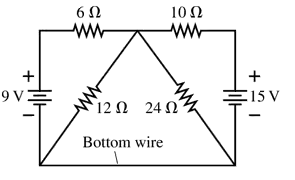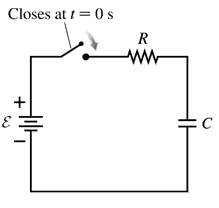 Back
BackProblem 64b
A 12 V car battery dies not so much because its voltage drops but because chemical reactions increase its internal resistance. A good battery connected with jumper cables can both start the engine and recharge the dead battery. Consider the automotive circuit of FIGURE P28.64. How much current is the dead battery alone able to drive through the starter motor?
Problem 66
How much current flows through the bottom wire in FIGURE P28.66, and in which direction?
Problem 67
The capacitor in an RC circuit is discharged with a time constant of 10 ms. At what time after the discharge begins are (a) the charge on the capacitor reduced to half its initial value and (b) the energy stored in the capacitor reduced to half its initial value?
Problem 68
A circuit you’re using discharges a 20 μF capacitor through an unknown resistor. After charging the capacitor, you close a switch at t = 0 s and then monitor the resistor current with an ammeter. Your data are as follows: Use an appropriate graph of the data to determine (a) the resistance and (b) the initial capacitor voltage.
Problem 69
A 150 μF defibrillator capacitor is charged to 1500 V. When fired through a patient’s chest, it loses 95% of its charge in 40 ms. What is the resistance of the patient’s chest?
Problem 72
A 15 μF capacitor charged to 12 V is discharged through a resistor. The energy stored in the capacitor decreases by 50% in 0.25 s. What is the value of the resistance?
Problem 73d
The capacitor in FIGURE P28.73 begins to charge after the switch closes at t = 0 s. Find an expression for the current I at time t. Graph I from t = 0 to t = 5τ.
Problem 75b
The flash on a compact camera stores energy in a 120 μF capacitor that is charged to 220 V. When the flash is fired, the capacitor is quickly discharged through a lightbulb with 5.0 Ω of resistance. At what rate is the lightbulb dissipating energy 250 μs after the flash is fired?
Problem 80
You’ve made the finals of the Science Olympics! As one of your tasks, you’re given 1.0 g of aluminum and asked to make a wire, using all the aluminum, that will dissipate 7.5 W when connected to a 1.5 V battery. What length and diameter will you choose for your wire?



